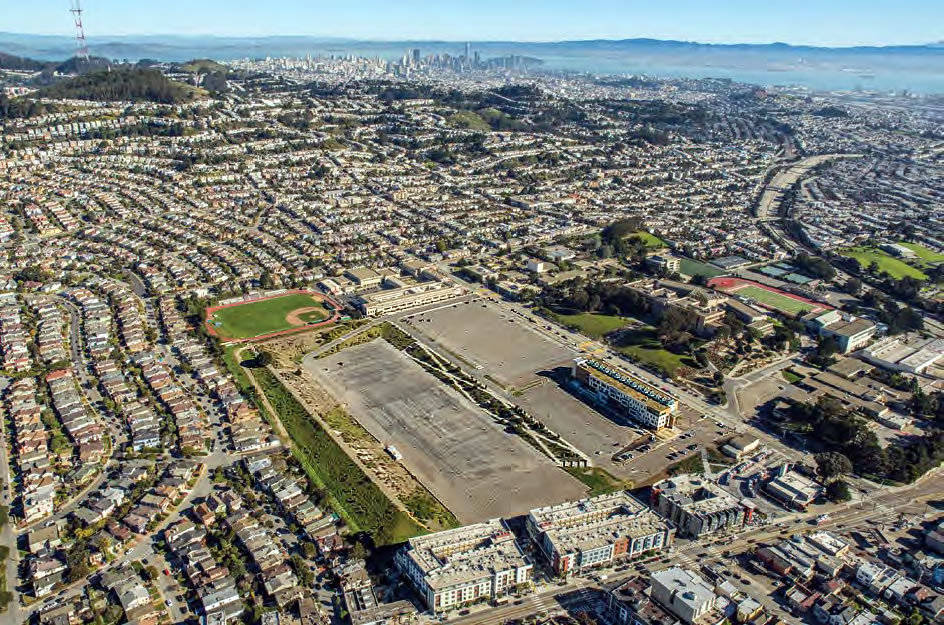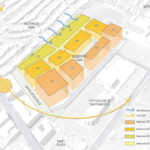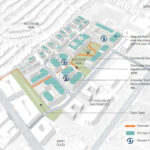The detailed Design Standards and Guidelines (DSG) document for the proposed redevelopment of San Francisco’s Balboa Reservoir has just been released, with the project team aiming to secure approvals from the City’s Planning Commission, Public Utilities Commission and SFMTA Board over the next two quarters and final approval from San Francisco’s Board of Supervisors this July.
The nine core principles of the DSG, which will guide the design of the streets, open spaces and buildings within the new 17-acre “Balboa Reservoir neighborhood” and is intended to create “a bold, cohesive addition at the juncture between City College of San Francisco and the Ingleside, Westwood Park, Sunnyside and Ocean Avenue neighborhoods,” adjacent to CCSF’s proposed Performing Arts Center project:
1. Provide distinct and approachable places throughout the neighborhood
The neighborhood will be characterized by a range of spaces from the intimately-scaled to larger public spaces in order to maximize outdoor activity and to provide opportunities for recreation and socialization for neighbors.
2. Integrate and connect built and landscaped spaces
Design elements will blur the lines between indoors and outdoor to respect the unique traditions of the San Francisco Bay Area. Buildings will integrate with the surrounding landscape and exterior materials will extend into interior spaces.
3. Celebrate the setting of the Balboa Reservoir through design
The setting of the Balboa Reservoir is bounded by the surrounding hills and characterized by distant views to the Pacific Ocean; design of open spaces and buildings will emphasize views and celebrate topographic context
4. Contribute to the existing neighborhood and reinforce neighborhood places
The Balboa Reservoir has historically existed apart from neighboring communities and institutions. The Reservoir Neighborhood will provide connections with surrounding neighborhoods and surrounding institutional uses.
5. Respond to the ecology of the site with specific design strategies
The Balboa Reservoir is a unique place punctuated by wind and fog. The place of the Reservoir neighborhood will be informed by and be compatible with these local climate conditions.
6. Prioritize a cohesive appearance for the Reservoir neighborhood
The architectural context of the Balboa Reservoir site is characterized by institutions and cohesively designed neighborhoods. The Reservoir Neighborhood will provide a continuity of architectural expression, created through collaborative design to respect this context.
7. Design with the ground floor in mind
The design of the buildings and open spaces in the Balboa Reservoir neighborhood will prioritize lived experience at the street level. Care will be taken to create active ground floor uses and to provide quality materials and details to support the pedestrian experience.
8. Weave sustainability throughout the built fabric
As a responsible neighbor, the Balboa Reservoir neighborhood seeks to minimize its ecological footprint. The neighborhood will set aggregate sustainability goals and individual projects will instill sustainability in all facets of design.
9. Leverage design to solve problemsOpen space and building design processes for the Balboa Reservoir neighborhood will harness design to solve functional problems and will use these opportunities to reflect these Design Principles
The DSG document will be presented to the Balboa Reservoir Community Advisory Committee (CAC) next month, with a number of key design elements of the project having been changed since first envisioned, including street realignments, proposed massings and a re-orientation of the central Reservoir Park (“to provide better shelter from prevailing ocean breezes, to maximize solar access, and to provide a stronger connection to north and east neighborhoods”).
And assuming the redevelopment is approved and the necessary development agreements are adopted, the timeline for the phased, 1,100-unit project still calls for breaking ground next year, finishing up the first phase of construction by 2025 and completing the project around 2027, depending upon financing and market conditions.



The utter lack of any kind of density is astounding.
This site is so near multiple mass transit options, across the street from SF City College, is right next to freeways and is a municipal owned property.
I guess this is just another example of our lack of interest in doing anything to try to address the housing crisis in San Francisco and the greater Bay Area as a whole.
Sad and true. I expect the height to whittled down further and for development to break ground in 2030ish.
You can argue it should be denser, but you can’t argue that’s it’s not dense by SF standards. Claiming otherwise is quite literally mathematically untrue.
Agreed. They have peak heights of eight stories to feint towards density and appease urbanists, but the wide streets and the townhouse “buffer” component lower the density to barely half of what old New York City neighborhoods (and our Chinatown) achieve through mostly four floors and corner stores. It’s a waste of a rare large development site, and a sick joke to then ask proposals to “weave sustainability” into the design of said low-density development.
Maybe San Franciscans need to go to the ballot to demand higher density here.
4- story townhomes as transition buildings are a good example. We can learn from Old New York City Neighborhoods indeed!
The utter lack of infrastructural investment in balboa park station vs downtown is the issue. It’s the second largest hub and should be treated as such. An intermodal transfer station between the JKMT lines and direct links to D7 and D10 developments along with bicounty transit growth in Daly City and SSF with high speed rail links… taller and bigger buildings should mandate equitable transit investment / water power schools pools libraries and emergency systems… police fire and EMT services along with a better link or a new south side hospital/ER…
Aaron, The April 20 meeting of the Balboa Reservoir CAC will center on these issues. Please come and bring your thoughts.
This should all be ’85 feet which would maximize the yield of podium construction. If this goes through with over ~35% of the project with height limits under 35′, sad sad day for San Francisco….
It’s reasonable to provide a transition for the SFHs in Westwood, not just brutally slapping 85 foot highrises right in front of them.
Yes, it may eliminate badly-needed housing, but at least it won’t brutally assault the neighbors with visible apartments. I mean, just look at what happened to Pacific Heights when 85 foot buildings were allowed!
I would be open to demolishing some of the houses in Westwood and replacing them with taller structures to ease the transition.
But will it be vibrant?
Disappointed in the height limits. Space is at a premium, and this seems like such a waste.
Why does the City College portion only have one small building on it. Are they planning some development as well?
As linked above: Questions about CCSF’s Performing Arts Center and Parking Emerge
This should be 3x the number of units. Why are we so under building on a site like this?
Because we are ‘celebrating topographic context’ and sweeping Pacific Ocean views.
And because it would be brutal–brutal!–to build 85 foot high buildings. The humanity!
so much planning.
“The Balboa Reservoir is a unique place punctuated by wind and fog. The place of the Reservoir neighborhood will be informed by and be compatible with these local climate conditions.”
So i grew up in the outter Richmond around 29th and california. Wind and fog and damp during our “summer”, you deal with it until September, kinda like they do now in the northeast. Oh yes i was “informed” by these conditions!
Lots and lots of planner babble in these precepts…
UPDATE: Balboa Reservoir Redevelopment Positioned for Approval, But…